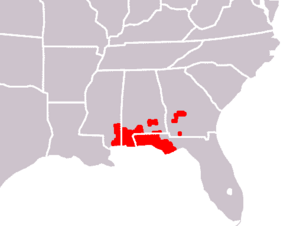Crimson pitcherplant facts for kids
Quick facts for kids White pitcher plant |
|
|---|---|
 |
|
| Conservation status | |
| Scientific classification | |
| Genus: |
Sarracenia
|
| Species: |
leucophylla
|
 |
|
| Sarracenia leucophylla range | |
| Synonyms | |
|
|
The White Pitcher Plant (scientific name: Sarracenia leucophylla) is a really cool carnivorous plant. This means it eats insects! It's also called the crimson pitcherplant or purple trumpet-leaf because of its colors. It belongs to a group of plants called Sarracenia.
Contents
Where the White Pitcher Plant Lives
Like all Sarracenia plants, the White Pitcher Plant comes from North America. It grows naturally only in the Southeastern United States. This means it is endemic to that area.
You can find it in wet, low-nutrient areas called savannas. These savannas often have longleaf pine trees. The plant mostly lives along the United States Gulf Coast. It is found west of the Apalachicola River in the Florida Panhandle. You can also see it in Alabama, Georgia, Louisiana, Mississippi, and North Carolina. In North Carolina, people have sometimes planted it in new areas.
What the White Pitcher Plant Looks Like
The White Pitcher Plant has unique flowers and leaves. Its flowers are brownish-red and hang down. Its leaves are hollow and shaped like pitchers. They stand up tall.
The top part of each leaf is colorful. It has reddish-purple veins on a white background. A round, wavy-edged hood sits on top of the pitcher. This hood helps to attract insects.
These plants can be different heights. Some can grow almost 1 metre (3.3 ft) tall. Others are much smaller. There's even a tiny dwarf form that is only about 30 centimetres (12 in) tall. This small version lives only in Garcon Point in Florida.
Why the White Pitcher Plant Needs Help
The White Pitcher Plant is a vulnerable species. This means it is at risk of disappearing. It is listed on the IUCN Red List of Threatened Species.
The biggest danger to this plant is losing its home. Its special wetland habitats along the Gulf Coast are being built on. Also, forests are growing too much in areas where wildfires used to keep them open. Wildfires naturally helped these plants by clearing out other plants.
Another problem is that the White Pitcher Plant is very beautiful. It is one of the largest and showiest Sarracenia species. This makes it a target for people who illegally take plants from the wild. It is also sometimes cut for use in flower arrangements.
Growing White Pitcher Plants
People grow Sarracenia leucophylla as an ornamental plant. Even though it's from the warm Southeastern U.S., it can handle cold weather. You can grow it outside in places like USDA zones 6 if you protect it in winter.
When growing it, make sure the soil drains well. It needs to stay moist, but not too wet. Too much standing water can cause the roots to rot.
Some special types of this plant are known:
- Schnell's Ghost: This type has yellow flowers. Its pitchers have very little red color.
- Hurricane Creek White: These are mostly white plants from Hurricane Creek, Alabama.
- Tarnok: This is a special plant that grows a showy double flower. However, this flower cannot produce seeds.
- Titan: This is a very tall and strong type. Its fall pitchers can grow to be over 38 inches (97 cm) tall!
Gallery
See also
 In Spanish: Sarracenia leucophylla para niños
In Spanish: Sarracenia leucophylla para niños







